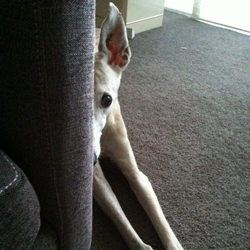GREYHOUND CARE: Traveling with Greys
 Traveling with Greys
Traveling with Greys
See also the very useful article, Traveling by Car or Truck with Pets. A big thank you for this link to Julia and the other kids who get together with volunteer Victoria Whaley at the Laramie Public Library!
Protecting and restraining
Keeping a dog on a leash or in a fenced area at all times is best for the dog for the following reasons:
• It keeps the dog from injury by traffic, fights, and other dangers.
• It fosters good neighbor relations by avoiding destructive behavior, annoyance, and injury.
• It helps develop an affectionate pet by giving the dog assurance that it is a protected part of the “pack.”
This is particularly important for greyhound owners for the following reasons:
• Your dog can spot something the size of a rabbit 1/2 mile away and can reach approximately 45 mph in 3 strides. Even if your dog is trained, once it begins to run it cannot hear your commands. (Think of someone trying to yell at you when you’re driving 45 mph.)
• Your dog’s speed also makes it virtually impossible for an oncoming car to avoid hitting him or her should your dog run into the street.
Letting a dog off leash outside of a fenced area is truly one of the most dangerous behaviors of uninformed dog owners.
Auto safety
We encourage you to incorporate your dog into as much of your life as possible. Dogs want to be with their owners--that is their “goal” in life. Whether this is your goal or you simply want to take your dog to the veterinarian in peace and safety, car manners are a must.
Start with short drives around the block and work up. Dogs who start out frightened beyond belief soon warm up to the sight of “their” car when they learn the vehicle represents fun outings.
NEVER leave a dog in a parked car on days that are even moderately warm. The temperature inside a parked car can rise to over 100 degrees in less than 10 minutes, even when the outside temperature is only 80 degrees. Heatstroke may occur whenever a dog’s temperature rises above 104 degrees. Pets with heatstroke can suffer brain damage or worse in a matter of minutes. This quickly becomes life-threatening. If this happens, get your dog to a veterinarian immediately. (For more information, see Cars, Hot Weather and Your Greyhound.)
Pet travel and lodging resources
A number of organizations offer advice and resources for traveling with pets, including searchable lists of lodging establishments that accept pets.
• DogFriendly.com
• PetTravel.com
• petswelcome.com
• Travel Pets
Protecting and restraining
Keeping a dog on a leash or in a fenced area at all times is best for the dog for the following reasons:
• It keeps the dog from injury by traffic, fights, and other dangers.
• It fosters good neighbor relations by avoiding destructive behavior, annoyance, and injury.
• It helps develop an affectionate pet by giving the dog assurance that it is a protected part of the “pack.”
This is particularly important for greyhound owners for the following reasons:
• Your dog can spot something the size of a rabbit 1/2 mile away and can reach approximately 45 mph in 3 strides. Even if your dog is trained, once it begins to run it cannot hear your commands. (Think of someone trying to yell at you when you’re driving 45 mph.)
• Your dog’s speed also makes it virtually impossible for an oncoming car to avoid hitting him or her should your dog run into the street.
Letting a dog off leash outside of a fenced area is truly one of the most dangerous behaviors of uninformed dog owners.
Auto safety
We encourage you to incorporate your dog into as much of your life as possible. Dogs want to be with their owners--that is their “goal” in life. Whether this is your goal or you simply want to take your dog to the veterinarian in peace and safety, car manners are a must.
Start with short drives around the block and work up. Dogs who start out frightened beyond belief soon warm up to the sight of “their” car when they learn the vehicle represents fun outings.
NEVER leave a dog in a parked car on days that are even moderately warm. The temperature inside a parked car can rise to over 100 degrees in less than 10 minutes, even when the outside temperature is only 80 degrees. Heatstroke may occur whenever a dog’s temperature rises above 104 degrees. Pets with heatstroke can suffer brain damage or worse in a matter of minutes. This quickly becomes life-threatening. If this happens, get your dog to a veterinarian immediately. (For more information, see Cars, Hot Weather and Your Greyhound.)
Pet travel and lodging resources
A number of organizations offer advice and resources for traveling with pets, including searchable lists of lodging establishments that accept pets.
• DogFriendly.com
• PetTravel.com
• petswelcome.com
• Travel Pets
This section includes short articles on topics on how to care for your greyhound. Many of the articles came from prior newsletters or were written to address problems or as answer specific questions as they arose. This section will be added to over time as issues come up and/or if new information becomes available. If you have a topic you would like addressed in this section contact us.













